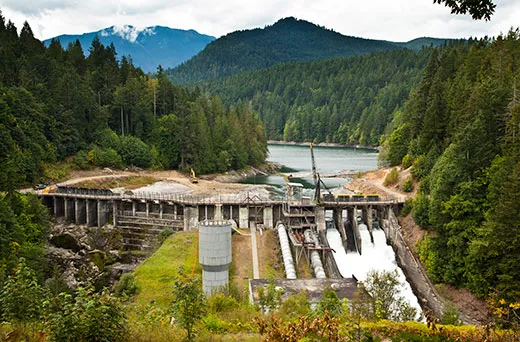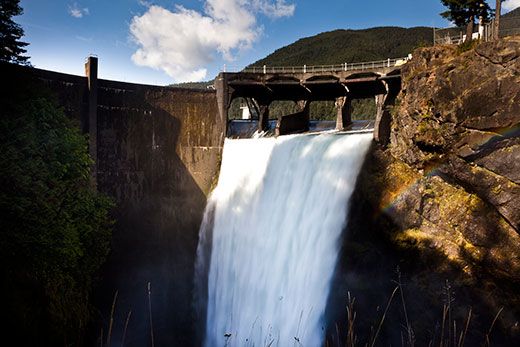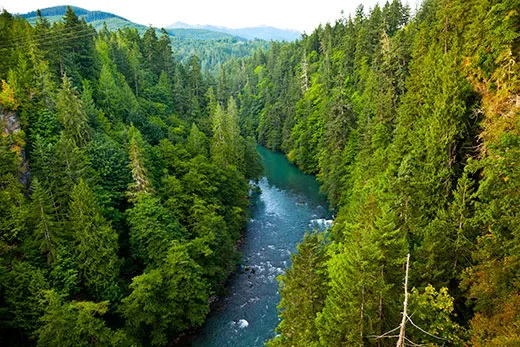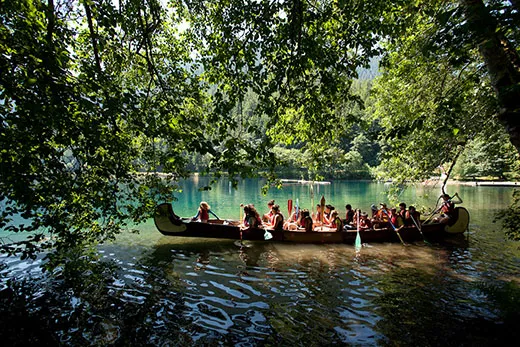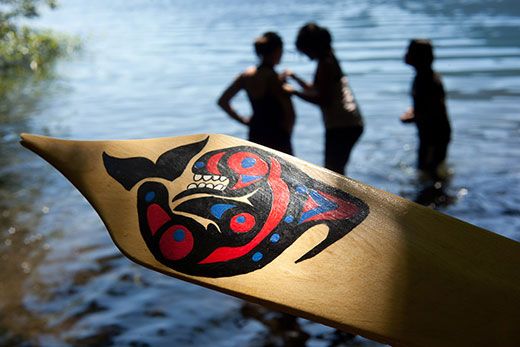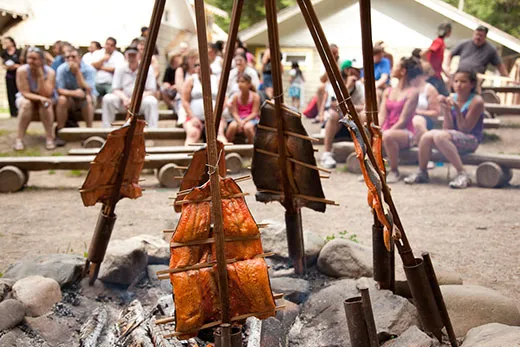On the Elwha, a New Life When the Dam Breaks
A huge dam-removal project will reveal sacred Native American lands that have been flooded for a century
/https://tf-cmsv2-smithsonianmag-media.s3.amazonaws.com/filer/Elwha-River-dam-removal-631.jpg)
The nation’s largest and most ambitious dam removal will begin this month, when workers start demolishing two antique dams on Washington state’s Elwha River. The Elwha has been cut off from its source in the Olympic Mountains for almost a century, and its once rich salmon runs have dwindled to practically nothing.
The dams will be notched down gradually, over three years, and it will take even longer for fish to return in force. Yet the Lower Elwha Klallam tribe, whose culture is rooted in the river, already feels the project’s impact. I visited the watershed before demolition began, as some of the tribe’s youngest members awaited the river’s transformation.
Several dozen middle schoolers raced to their picnic spot on the weedy banks of the Lake Aldwell reservoir, one of two dammed segments of the Elwha River. It was the first day of a week long camping trip, and already their counselors, lugging tubs of peanut butter, looked a bit exhausted. The campers’ happy shrieks echoed in the cedar trees.
Yet when tribal elder Monica Charles put aside her cane and sat down near the water’s edge to tell stories, the kids grew quiet.
Tucking long gray hair behind her ears, Charles told the children that they were sacred beings, which made some of the boys blush. She reminded them of their eternal ties to their tribe, and said that no matter where their paths in life led, they each had a special duty to perform for their people. She compared them to the Pacific salmon native to the Elwha, which swim out to sea as juveniles but return to home waters as adults.
“There’s an instinct in the young salmon that makes them go downriver,” she explained. “They go down waterfalls and through the white-water. They go out to the ocean to see the world.
“But they don’t get lost. And they always find their way back.”
Except that the Elwha’s salmon haven’t really been back for a century now. The river—most of which is inside Olympic National Park—once shimmered with tens of thousands of the fish, but thanks to the dams and related environmental problems, only a tiny percentage of the historic wild runs endure. Blocked from their upriver spawning habitat, a few determined salmon still gather at the base of the lower dam every year during spawning season.
Scientists are on hand as the first pieces of the dam are about to be removed. They will monitor the river valley’s renaissance and the return of the fish. They have carefully modeled how the plume of sediment trapped behind the dams will travel downriver and empty into the salt water of the Strait of Juan de Fuca.
The effect on people, though, is harder to predict. In anticipation of the dam’s removal, the Elwha Science Education Project, hosted by the Olympic Park Institute (OPI), a local environmental group, is holding camps and field trips to reconnect Elwha children, as well as some from other local tribes, with the watershed that was once the Elwhas’ world. The hope is to send kids from the tribe—which has low high-school graduation rates—to college, with the ultimate goal of having them return home to the Olympic Peninsula to work, perhaps even as scientists studying the transitioning watershed.
“We want them to think, ‘Maybe science is something I could do,’” said Robert Young, a coastal geoscientist who helped secure National Science Foundation funding for the program. “We want them to say, ‘I could be fixing this river. I could be helping it heal. I could be uncovering sacred sites. That can be me. And it should be me.’”
Beneath the reservoir’s surface, not far from the spot where Charles told her stories, lies a rock with two holes shaped like coil baskets, Elwha elders say. This is the tribe’s creation site, where God washed the people clean in the river water. For generations, young people visited the rock and meditated to learn what their future held.
But these days it’s hard to see the future, because the rock has been underwater for nearly 100 years.
***
The best way to understand the dams’ impact is to rise above the 200-foot fir and spruce spires of the Olympic Peninsula and view the river from the air, and so I chartered a two-seater plane. When it lifted above the marine fog, a tunnel seemed to open in the clouds, wandering above the Elwha into the high peaks. We were hoping to glimpse the river’s source, an avalanche-fed snowfield called the Snowfinger.
Behind us, on both sides of the river’s mouth, the Elwha reservation lay flat as an open palm. A long sand spit called the Ediz Hook crooked an emaciated finger out to sea. The Elwha Valley looks like a notch into an otherwise impenetrable wall of the Olympic Mountains—an ideal hangout spot for the gods the native people believed lived there.
We turned toward the mountains. The Elwha and its tributaries offer more than 70 miles of textbook salmon-spawning habitat, most of it practically pristine because it is within the bounds of a national park. Steep, tumbling and fiercely cold near its source, toward its mouth the river lazily wags back and forth across the flood plain, gushing turquoise with melted snow.
We passed over the two horseshoe-shaped dams and their reservoirs, 267-acre Lake Aldwell and, above it, 415-acre Lake Mills. Heaps of timber, which from such a distance looked like neat little stacks of matchsticks, clogged the dam in spots, and I could see the giant clots of sediment behind the dam—more than 20 million cubic yards of hoarded sand that belongs downriver.
Above the dams, the Elwha narrowed and steepened; the surface was scuffed with rapids in places, and rafters floated in inner tubes tiny as Cheerios. The snow-decked mountains we skirted were blotchy with the shadows of clouds. According to Elwha mythology, a storm god called the Thunderbird helps chase the salmon upriver, and indeed some of the highest peaks were scorched where lightning had struck again and again.
Waterfalls charged down the mountainsides and tributaries pumped frantically into the swerving, frenetic Elwha. Here and there were exposed gravel bars and other spots where the river had changed its mind over the years and sashayed away in another direction.
But despite its spirited appearance, the Elwha is barely alive. Only the five miles of habitat below the dams is currently accessible to salmon. Historically the river produced some 400,000 wild adult salmon annually; today it’s closer to 3,000.
The exile of the salmon has meant the banishment of other animals that otherwise would feast on the fish. The area’s populations of bobcats, bear, mink and river otter have likely declined. In similar ecosystems in nearby Canada, there are “bald eagles like mosquitoes,” Young says. But they appear to be much more rare on the Elwha. Since salmon carcasses aren’t fertilizing riverside vegetation with nutrients brought upstream from the ocean, even the cedars starve.
Pat Crain, a park fisheries biologist, snorkeled portions of the Elwha a few years ago, drifting “like a log” down the river and tallying all the living creatures he encountered by making hash marks on a piece of PVC pipe strapped to his arm. He glimpsed thousands of rainbow trout above the dams, but “there were long stretches where we saw virtually nothing.” Just mile after mile of perfect, deserted salmon habitat.
Yet the one snippet of river that the fish can still access—the five miles below the first dam— is in the worst shape of all. “Down there is terrible habitat,” Crain said, “but that’s where the fish are trying to live.”
Because the river water heats up in the reservoirs before it’s released, temperatures downstream are too warm for the salmon; the heat reduces the water’s oxygen stores and spurs the spread of disease. In the early 1990s, for instance, 70 percent of the river’s chinook died before spawning, and the run never fully recovered. Also, because almost all the timber gets caught behind the dams, the lower Elwha has few logjams to create the pools and channels that shelter juvenile fish. In recent years, the tribe has begun constructing artificial logjams.
The worst problem downstream, though, is the lack of usable sediment. Salmon need gravel of a certain size to bury their eggs. Normally, eroded particles from the Olympic Mountains, washed downriver, would replenish the gravel supply, which the Elwha continuously pushes out to sea. But the dams block the sediment from reaching the lower river, where the bottom now is just boulders in places.
The dearth of new sand and gravel also degrades the delta and beaches, which are composed almost entirely of large cobbles now. “We used to have shellfish and clams on our beaches,” Robert Elofson, the tribe’s river restoration director, told me. “Had a geoduck bed out there, but the quality and size of the bed have been impacted. Eelgrass and kelp are impacted too.”
Amazingly, DNA tests have shown that descendants of nearly all the Elwha’s species of wild salmon may still inhabit the river, including chinook and king salmon, coho, pink and chum. The only ones that have likely been eliminated are the native sockeye, which spawned exclusively in a natural lake above the dams. “When the dams went in, their life history trajectory was immediately cut off,” says Mike McHenry, the tribe’s habitat program manager. The other fish still come back to spawn in small numbers, which should grow significantly when the dams are gone. Today only about 200 pink salmon breed in the river, for instance; in the future, park fisheries biologists expect roughly 100,000.
Our propeller plane was now bobbing and dipping in the thick of the mountains. Below us the headwaters of the Elwha frothed white with effort. To get this far on foot entails a grueling three-day backpacking trip; I tried to imagine the willpower necessary to arrive as chinook once did, by water, battling for dozens of miles against rapids and a ripping current.
Suddenly the misty gray ceiling above us lifted, and we were in a cathedral dome of clouds. The pilot mumbled into his mouthpiece and pointed ahead, and I saw a hammock of pure whiteness nestled between mountains. The Snowfinger.
***
People have been living near the Elwha for thousands of years. For much of their history, the Klallam people (the Lower Elwha Klallam are one of three remaining populations of this larger group) wore cedar bark clothes, dabbed their faces with red ocher for spiritual protection and shook deafening deer hoof rattles during grand feasts. The salmon migrations were always at the heart of the culture. In an annual ceremony, the head and bones of the first salmon of the year were carefully arrayed on a cedar mat and set adrift on the Elwha, which would carry the body back out to sea. The people hoped this initial fish would then tell its fellows how honorably it had been treated, so they, too, would return to their birth river.
The Klallams’ first contact with Europeans came in July of 1790, when a Spanish vessel searching for the Northwest Passage encountered two canoes. The sailors traded bits of iron for fresh salmon berries, the Spanish commander wrote in his journal, and the Indians filled the visitors’ empty water casks “with delicious water taken from a beautiful stream,” the Elwha.
It wasn’t long before the usual ruin befell the Klallam tribes, as Lynda Mapes recalls in Breaking Ground, her powerful history of the Elwha people. Smallpox killed some 80 percent of Pacific Northwest Indians within 100 years of contact, and archaeologists recently found what are likely smallpox graves at Tse-whit-zen, a major Klallam village near the Elwha River’s mouth.
In 1855, beleaguered Klallam leaders signed the Treaty of Point No Point, relinquishing more than 400,000 acres of their lands, including the Elwha, for $300,000. The Klallam were assigned to live on a reservation about 100 miles away. Many, though, refused to leave. They squatted near the river’s mouth or tried homesteading along its banks, often eating salmon three meals a day – baked, smoked, in potato soup or with hash for breakfast – until the state of Washington banned them from fishing. The Klallam resorted to poaching, and some were jailed.
The tribe eventually received its own reservation lands, and in the 1970s a federal court ruled that Indians were entitled to half of the salmon catch in all their traditional waters.
But by then the Elwha fish were long gone.
As the Klallam culture was declining at the turn of the 20th century, a new community rose up and took its place: Port Angeles. Once a primitive outpost, it was transformed into a tidy industrial port in the wilderness, courtesy of a swashbuckling youth named Thomas Aldwell.
When Aldwell first saw the Elwha, its wildness charmed him. “That spring embodied all of life and beauty I thought I’d ever want,” Aldwell wrote in his self-congratulatory memoir, Conquering the Last Frontier. He bought land along the river and bushwhacked in to homestead. But his admiration for the carefree Elwha quickly became more calculated. “It was not until I saw it as a source of electric power for Port Angeles and the whole Olympic Peninsula that it magnetized all my energies,” he wrote. “Suddenly the Elwha was no longer a wild stream crashing down to the Strait, the Elwha was peace, power and civilization.”
He set about building the lower dam, which created Lake Aldwell, in 1910. Though the national park didn’t yet exist, environmental officials reminded him of his legal obligation to build a fish ladder for migrating salmon. Aldwell ignored letters from game wardens and bemoaned costs, finally electing to build a hatchery below the dams instead. The hatchery was an incompetent operation that ceased functioning after a few years.
While still under construction in 1912, the dam burst, sending a wall of water barreling down on the Indian homesteaders along the river. Nobody died, but dead fish hung in the trees for days, and suddenly the river was not to be trusted.
The dam was patched with rock and mattresses of Douglas fir, and before long Port Angeles glittered with electric lights. A second, even bigger dam was built in 1927, eight miles upstream.
Today the logging town of Port Angeles is sleepy and isolated, pressed between the mountains and the sea, lonely foghorns in the little harbor as resonant as organ chords. The dams most recently provided only about half the power for a single paper mill. A store near the waterfront, Dazzled by Twilight, caters to the gloomy-looking teenage pilgrims of the popular Twilight vampire novels, which are set in the nearby town of Forks.
***
Forbidden to use their own language in public school, the Klallam people stopped speaking it. Shaker missionaries introduced a new religion to the tribe, and the First Salmon ceremony was abandoned. Eventually all save a handful of Klallam songs were lost. Forced by the fishing ban to find other work, people began leaving the Elwha watershed.
Children were shipped off to Indian schools in New Mexico and Oklahoma to learn menial professions and make their way in the wider world. Adeline Smith was among those sent away. Born in 1918, she grew up on a homestead along the Elwha but left for an Indian school in Oregon to learn to be a maid. Today she lives on the Elwha reservation in a trailer the color of daffodils. Smith has a fluff of gray hair and a smiling face with deeply pressed wrinkles. When I met her, she was wearing all white: spotless sandals and dress, pearl hoops in her ears. One of a handful of fluent Elwha speakers, she is revered as a symbol of the tribe’s endurance; other members are meek as children in her presence. But she frankly says she was grateful to leave Port Angeles to learn a trade, had a good life as a housekeeper and seamstress in Seattle, and never dreamed of returning home until family affairs brought her back in 1983. As a child, she remembers letting her parents’ words rush past her like water.
“We used to get so tired sometimes when they’d sit us down for the stories,” she said. “Over and over, they’d try to embed them. Now I feel bad that I didn’t really listen, listen as hard as I could.” Most of those stories are now lost.
The Elwha people have always opposed the dams, but removal only began seeming like a viable option in the 1970s, when questions about the structure’s safety and environmental impacts arose. In 1992, President George H.W. Bush signed the Elwha River Ecosystem and Fisheries Restoration Act. A series of studies showed the best way to restore the watershed was to remove the dams.
Smith still can’t quite believe she’ll live to see the dams come down, and, perhaps, the Klallam creation site come to light.
“I doubt that rock is there,” she said. “A lot of things have changed with the river. Whatever is down below, they dynamited it. All that erosion.”
The day I met Smith, I also toured the 1,000-acre reservation and adjacent lands, where several hundred of the tribe’s 1,000 or so members live. The wind-mussed meadows and marshes have to be among the most beautiful spots in the world, with hummingbirds zipping everywhere and the mountains huddled around as though they could not resist gazing down on this place.
Lately the reservation buzzes with progress. A new casino employs dozens of people and has a removable wall for future expansion. A state-of-the-art fish hatchery is under construction, a heritage center opened in downtown Port Angeles to teach job skills, and the community offers many services, from day care to vast stacks of free firewood cut for the elders. Lately, the waiting list for reservation housing has swelled. Maybe it’s just the bad economy, says tribal vice chairman Russell Hepfer, but for whatever reason many tribal members are finally feeling the urge to come home.
Today the tribe participates in canoe paddles and ceremonies with other Indians. Members have reinstituted the First Salmon ceremony and given salmon (often caught in other rivers) as Christmas presents, smoking the fish in cramped, fragrant outbuildings, using alder wood for heat and maple for sweetness.
The cultural revival does not interest everyone.
“We tried for years to teach the language to adults in the community,” explained Jamie Valadez, the tribe’s language educator. “We didn’t get very far— they were stuck in the mud. It was very frustrating. Our elders were passing away. Then it hit us: We have to focus on the kids.” They now offer Klallam classes at the Port Angeles high school, as well as a traditional dance program. Successful kids might come back to help their people—which is why tribal members, even those without school-age children, harbor such high hopes for the science education project.
“If we can have even one person come back to work on the Elwha, it would be worth it,” says Hepfer, who wears a tattoo of a leaping salmon on his shoulder and is one of the few in the tribe who still visit the river to pray.
***
Some of the kids at the middle school camp already knew the saga of the Elwha and its people well enough to tell it; others had never even heard the creation story, and a few didn’t know how to spell the river’s name.
But for a week, all of them were immersed in Elwha science and ancestral culture. They went on a vision quest to a nearby hot spring. They played Plenty o’ Fish, a rather cerebral game of chase where they weighed a fisheries biologist’s advice about limited salmon harvests against a greedy grocery store agent’s bribes. They studied uses of native plants—how their ancestors spent their infancies in cedar cradles, how maple wood was carved into fish clubs, Oregon grapes were used for dye, fern roots pounded into flour, snowberries made into medicine, and of course, how alder wood was best for smoking salmon.
At night they wove cattail baskets and listened to stories about a mink whose salmon was stolen by a wolf, and a woman so dirty that skunk cabbage grew between her toes.
One day they visited an Olympic National Park nursery where hundreds of thousands of plants were being grown for the reservoir revegetation effort. They helped repot seedlings, and nursery manager Dave Allen showed them maps of where they’d be planted in the valley. He explained how important it is that the invasive plants don’t elbow out the native species when the soil is exposed and vulnerable. Restoring the forest will be a long battle.
“You guys will have lived your lives and this will still be evolving and changing into forest,” he said. “When you are old people—older than I am, even—you’ll still be seeing differences.”
The kids giggled at his floppy sun hat. They seemed at the moment more interested in discussing cellphone keyboards, chanting the local high-school fight song and engaging in the peculiar diplomacy of middle school flirting.
The highlight of camp was the canoe journey across Lake Crescent, a long, deep natural lake. Counselors told me beforehand that to Indian children, canoeing is a spiritual experience akin to church. But along with meditative moments, the multi-hour trip also offered ample opportunity for slaying daddy longlegs and dunking friends in lake water.
The kids occupied two huge fiberglass canoes, sitting three abreast in places. Each crew had dark designs on the other. Though they stroked with cedar paddles painted with peace signs, hostile choruses of “We Will Rock You” prevailed over traditional canoe songs. The campers’ competitive passions, alas, outstripped their nautical skills. The canoes turned in slow circles, some part of a precise ceremonial choreography, but most unintentional.
They had to hone their rowing technique quickly, though, as they would sleep in tents across the lake for the last night away from home, then sail back in glory the next afternoon to the camp beach, where parents and other members of the tribe would await their return.
Dinner that night, cooked over a campfire among the redolent cedars, was native foods, supplemented by teriyaki chicken bussed over from the dining hall. There was a pot of steamed stinging nettles, which made Jamie Valadez’s hands burn as she trimmed them, but which cooked up into a deep green, delicious dish like slightly sweet spinach. The counselors prepared oysters, which a few of the kids had never tasted. They gagged dramatically over the knifed-open raw ones, but when the counselors placed them in the campfire rocks, rounded side down so they cooked in their own juices, everybody asked for seconds.
The finishing touch was to have been a taste of salmon.
But when it came time to serve the fish, the counselors explained that they’d gone to the grocery store, where a single filet of white king salmon cost $60, and the program couldn’t afford it. Instead, they fashioned a cardboard cutout of a chinook. Using the model, they explained how the Klallam might have smoked salmon in strips or boiled it in a bentwood box, eating even the eyes and cheeks. They demonstrated how the Indians would push a butterflied fish onto a split stick leaned over the fire, catching the ocean-scented juices in an oyster shell to drink afterward. The kids watched with wide eyes. Breathing in the wood smoke, one could almost taste pink, flaking meat.
That night, the children practiced the welcome speeches they’d recite at the beach in front of their parents the next day, and the journey and greeting songs they’d been learning all week, which tribal members—grieved that the originals were lost—composed in the late 1980s and early 1990s for get-togethers with other tribes, and which typically have a strong rhythm meant to be banged out by drums or canoe paddles.
They also sang one of the sole surviving Klallam songs, antique recordings of which date from the 1920s. All modern Elwha ceremonies end with its singing.
But this is not a thumping, enthusiastic paddling anthem. The haunting “Klallam Love Song” is about absence, longing and the possibility of return. Young women sang it when their husbands were away. The words are very simple, repeated over and over. “Sweetheart, sweetheart,” the women cried. “You are so very far away; my heart aches for you.”
Abigail Tucker is Smithsonian’s staff writer.
Planning Your Next Trip?
Explore great travel deals
Smithsonian magazine participates in affiliate link advertising programs. If you purchase an item through these links, we receive a commission.
